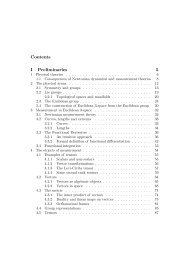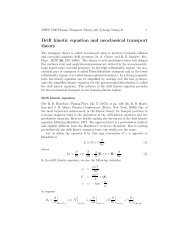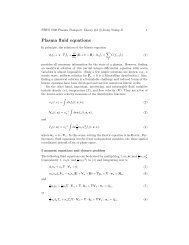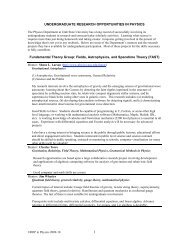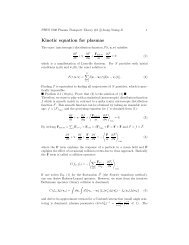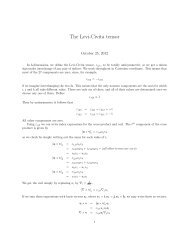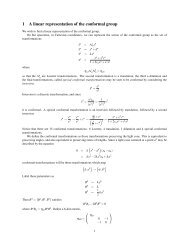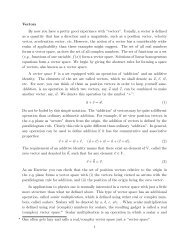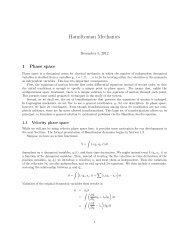- Page 1 and 2: Mechanics James T. Wheeler Septembe
- Page 3 and 4: 12 Special Relativity 122 12.1 Spac
- Page 5 and 6: Part I Preliminaries Geometry is ph
- Page 7 and 8: The first case is immediate because
- Page 9 and 10: in contradiction with x and y being
- Page 11 and 12: 1. For all A, B in τ, their inters
- Page 13 and 14: 1.3 The Euclidean group We now retu
- Page 15 and 16: Now, we see that the double sum of
- Page 17 and 18: To recover 3-dim space, we first id
- Page 19 and 20: Sometimes it is useful to think of
- Page 21 and 22: functional. Whereas a function retu
- Page 23: = ∣ ∣ ∣∣∣∣∣ ∣∣∣
- Page 27 and 28: The development of the theory of di
- Page 29 and 30: where h(λ) is arbitrary. In partic
- Page 31 and 32: Suppose g (x (β)) = ∫ h (x, x
- Page 33 and 34: = 1 ∫ ∫ dλ 1 2 + 1 ∫ ∫ dλ
- Page 35 and 36: ( ) If we want to know the position
- Page 37 and 38: 4.1.2 Vector transformations To hel
- Page 39 and 40: 4.1.4 Some second rank tensors Mome
- Page 41 and 42: The squared separation is therefore
- Page 43 and 44: 1. V is closed under addition. If u
- Page 45 and 46: 2. Functions on M. A function on a
- Page 47 and 48: together with the coordinate invari
- Page 49 and 50: 4.3 The metric We have already intr
- Page 51 and 52: Formally, we are treating the map g
- Page 53 and 54: When we do this, the only distincti
- Page 55 and 56: ( 2. Express the orthonormal basis
- Page 57 and 58: By constrast, suppose we know that
- Page 59 and 60: and so on so that e i ⊗ e j has a
- Page 61 and 62: y a Lie group. In the next sections
- Page 63 and 64: = = ∫ ∫ ( ∂L ∂x k ∂x k
- Page 65 and 66: where ε i (x) is a fixed function
- Page 67 and 68: is ∫ ( ) ∂L ∂L δS = δq +
- Page 69 and 70: Now consider the (vanishing) variat
- Page 71 and 72: so x i and v i are always parallel
- Page 73 and 74: Using scalings of the variables, we
- Page 75 and 76:
We map this point into a 1-dim cont
- Page 77 and 78:
for all δx. This p i is the genera
- Page 79 and 80:
is constant in time for all antisym
- Page 81 and 82:
7 The physical Lagrangian We have s
- Page 83 and 84:
where M i j and ai are constant. Th
- Page 85 and 86:
in the last step. We can give this
- Page 87 and 88:
7.3 Gauging Newton’s law Newton
- Page 89 and 90:
There are distinct advantages to th
- Page 91 and 92:
8 Motion in central forces While th
- Page 93 and 94:
Alternatively, after solving for
- Page 95 and 96:
Notice that now any transform of r
- Page 97 and 98:
1. At any given value of the energy
- Page 99 and 100:
so the condition requires −Ak 2 s
- Page 101 and 102:
Since j must be constant while x =
- Page 103 and 104:
Using the force law and the angular
- Page 105 and 106:
8.5.1 Conic sections We can charact
- Page 107 and 108:
Now, for the integral ∫ I = lim a
- Page 109 and 110:
do this. Since the force that maint
- Page 111 and 112:
Notice that the magnitude is mg cos
- Page 113 and 114:
Finally, substituting the expressio
- Page 115 and 116:
so The kinetic energy is therefore
- Page 117 and 118:
Newtonian mechanics. this is the on
- Page 119 and 120:
Now, dividing by ẋ and integratin
- Page 121 and 122:
where v = √ v 2 then the momenta
- Page 123 and 124:
Our most important tool is the inva
- Page 125 and 126:
and τ is invariant, we can find u
- Page 127 and 128:
12.3 Acceleration Next we consider
- Page 129 and 130:
Notice that P α β = δ β α + 1
- Page 131 and 132:
4. Show, using the constraint freel
- Page 133 and 134:
Add the first two and subtract the
- Page 135 and 136:
Once again cycling the indices, add
- Page 137 and 138:
The argument is the same as above,
- Page 139 and 140:
and the metric is ⎛ 1 η AB = ⎜
- Page 141 and 142:
and demanding that W m transform to
- Page 143 and 144:
or in a basis (dx α , dy α )as W
- Page 145 and 146:
acket we find 0 = δ { t, ξ A} = {
- Page 147 and 148:
This means that each p n 0 is suffi
- Page 149 and 150:
[ V i ] A dξA = − ∂H ∂p i dt
- Page 151 and 152:
is just 0 = dθ = dF i ∧ dx i =
- Page 153 and 154:
Note that Hamilton’s equations ar
- Page 155 and 156:
Consider what happens to Hamilton
- Page 157 and 158:
= = N∑ j=1 N∑ j=1 = ∂H ∂p i
- Page 159 and 160:
and let π j be the momentum variab
- Page 161 and 162:
This establishes that replacing the
- Page 163 and 164:
Write the quantum wave function as
- Page 165 and 166:
arbitrary functions, but we need to
- Page 167 and 168:
Hamilton’s principal function is
- Page 169 and 170:
Substituting into the expression fo
- Page 171 and 172:
16.2 Statistics and pseudomechanics
- Page 173 and 174:
we see that B b ε a bc is an eleme
- Page 175 and 176:
17 Gauge theory Recall our progress
- Page 177 and 178:
The identity is present because = A
- Page 179 and 180:
in the infinitesimal transformation
- Page 181 and 182:
y inserting identities to write [ A
- Page 183 and 184:
These properties - a vector space w
- Page 185 and 186:
matrix that depend on, say, N conti
- Page 187 and 188:
−J a (J c J b ) + (J a J c ) J b
- Page 189 and 190:
then For any odd-order form, ω, we
- Page 191 and 192:
17.4 The exterior derivative We may
- Page 193 and 194:
and further require the star to be
- Page 195 and 196:
where ( ) ∂x m J = det ∂y n is
- Page 197 and 198:
so ∇f = ∂f ∂ρ ˆρ + 1 ∂f
- Page 199 and 200:
= d ( e ijk ω i dx j dx k) = d (
- Page 201 and 202:
From Maxwell’s equations, ∗ d
- Page 203 and 204:
[33] Gorringe, V. M. and Leach, P.
- Page 205 and 206:
[79] Morgan, J. A., Spin and statis



